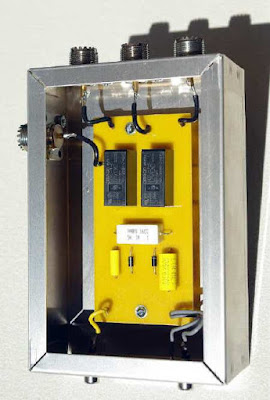Posts Tagged ‘WSPR’
 Saturday’s 630m Crossband Night – Reminder
Saturday’s 630m Crossband Night – Reminder
This is a reminder of tomorrow's '630m activity night'. Highlights of the evening will see six different Canadian stations seeking contacts with other amateurs in North America via the 'crossband mode' as they call CQ on 630m CW but listen for replies on their announced (QSX) HF frequency. As well, there will be an increased level of on-air activity from many of the U.S. experimental stations, as they beacon or work each other on various modes including CW and JT9, the WSPR QSO-mode. The experimental stations are also seeking your reception reports.
More information may be found here regarding the activity night, including a detailed list of participating Canadians along with their respective transmitting and QSX HF listening frequencies.
As is often the case, old 'Sol is threatening to throw some junk our way over the next day or two, right on time for our event but please don't let that stop you from participating as often this can actually enhance propagation, especially on the north-south path.
We hope to see many of you tomorrow night!
 630m VK’s Light-Up North America
630m VK’s Light-Up North America
It seems that all of my blogspots of late have focused on 630m propagation ... but what has been happening down there recently has been both amazing and somewhat unexpected. With the growing number of active stations listening and transmitting, the band's propagation capabilities and mysteries are quickly revealing themselves.
Last night was a great example but perhaps the WSPRnet prop map illustrates this best.
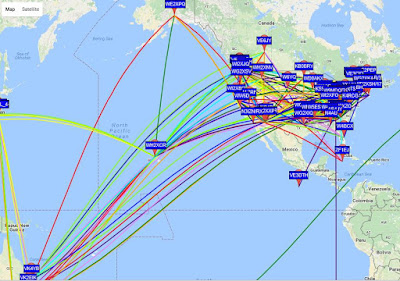 |
| courtesy: http://wsprnet.org/drupal/wsprnet/map |
Particularly striking was the long haul propagation from VK to North America, with northernmost VK4YB leading the pack. His 90 watt signal made it all the way to VE3IQB, near Ottawa as well as to NO3M, in Pennsylvania! To provide further hope to those that have little room for big receiving antennas, VE3IQB uses a typical small active e-probe antenna, 20' above ground!
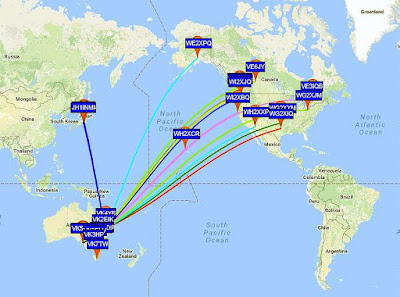 |
| courtesy: http://wsprnet.org/drupal/wsprnet/map |
 |
| courtesy: http://www.swpc.noaa.gov/ |
I'm theorizing that Roger's signal was arriving today at much lower angles than normal, evidenced by its far-reaching east coast reception and the fact that it couldn't get over my 600' local obstruction to the west. I've always believed that it takes higher angled signal arrival for me to hear Roger and today's events seem to support this.
Exactly what would cause this to be the case, I'll leave to the experts but I imagine that the sudden surge in geomagnetic activity played a significant role in today's very different propagation paths.
Roger was not the only VK lighting-up the map today. A much more detailed account of all the action can be found on the KB5NJD's daily 630m report here ... all very inspirational and hopefully enough to spur even more new activity on the MF band.
Why not give a listen and see what you can hear?
 VE3 – VE7 630m QSO
VE3 – VE7 630m QSO
The 630m band continues to provide interesting challenges for Canadian amateurs ... be they antenna, equipment or propagation related.
Sunday night produced another flurry of excitement on the new band, further demonstrating its potential for small stations operating from the suburbs.
On Sunday evening, VE3CIQ in Carleton Place, Ontario (southwest of Ottawa), and I, completed a two-way JT9 contact, following a short exchange of the required information (and more) just after midnight, Ontario time.
 |
| courtesy: https://www.google.ca/maps/ |
Noting the increased east-west favorability over the past few nights, Phil and I decided to give it a shot and were delighted to cover the 2200 mile / 3500km path while Murphy was sleeping and not messing with propagation.
Rather than randomly beacon on JT9, we both set 'calling each other' messages. Although this continued for some time, the QSO only took 12 minutes to complete once I started to decode Phil's signal out west. He had been decoding me and sending signal reports for a long time before his signal eventually peaked up here for the evening. I suspect that we could have continued the contact for the remainder of the night as his signal was getting stronger and stronger as we worked.
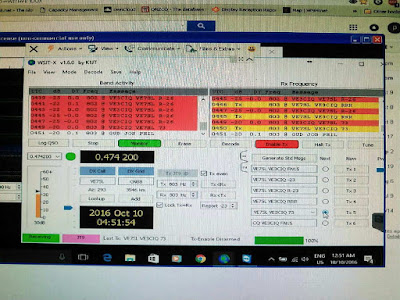 |
| Screen shot of QSO from VE3CIQ's end |
| VE3CIQ - 630m Station |
| VE3CIQ - Homebrew 630m Class-E Transmitter |
| VE3CIQ - 630m Linear-loaded Antenna |
Phil's station stands as yet another fine example of those living in the suburbs without a lot of room for antennas yet still able to successfully operate and explore our new 630m band. With a little ham-radio creativity, it's surprising how well a small station can perform, especially when the propagation co-operates.
Following our contact, I moved back to the WSPR section of the band and continued beaconing overnight.
Apparently Phil and I picked a good evening to run a sked as the overnight WSPR map shows it to have been the best night of the new DX season so far, with forty-four individual stations reporting my signal via the WSPRnet website.
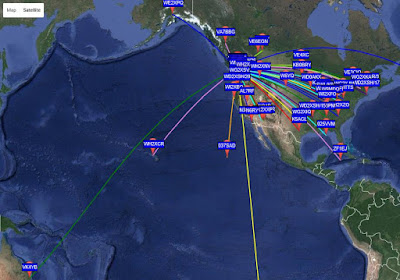 |
| courtesy: http://wsprnet.org/drupal/ |
 630m And Recent Geomagnetic Activity
630m And Recent Geomagnetic Activity

High levels of geomagnetic activity have usually, but not always, been the kiss-off-death for LF/MF propagation.
These past few months have seen fairly regular field disturbances, often pushing the K index to a level '5' or higher. However, while usually attenuating the east-west and northerly polar paths, the Trans-Pacific path often seems to benefit from these events ... particularly last night.
Perhaps it is related to the equinox's normal preference for this path or maybe the goop the sun is sending us at this point in the cycle is different or not as energetic as it is at mid-cycle. Nevertheless it's really encouraging to see that not all disturbances are detrimental to LF propagation.
For a daily summary of all overnight activity and much more, see KB5NJD's '630m Daily Reports'.
The WSPRnet map reproduced below shows the extent of reception during my own overnight WSPR 630m beaconing session. Missing are many of the normal spots from the eastern provinces and east coast states, indicating the attenuation on this path. Everything else seems enhanced.
 |
| courtesy: WSPRnet |
The path to down under, in-spite of my obstruction in that direction, perked-up as well, with VK4YB decoded here 19 times as well as VK3ELV's 150W and inverted-L near Wangaratta, Victoria.
13:56 VK4YB 0.4756 -28 QG62ku 11820
13:50 VK4YB 0.4756 -28 QG62ku 11820
13:44 VK4YB 0.4756 -24 QG62ku 11820
13:40 VK4YB 0.4756 -24 QG62ku 11820
13:30 VK4YB 0.4756 -27 QG62ku 11820
13:24 VK4YB 0.4756 -20 QG62ku 11820
13:18 VK4YB 0.4756 -24 QG62ku 11820
13:12 VK4YB 0.4756 -22 QG62ku 11820
12:42 VK4YB 0.4756 -26 QG62ku 11820
12:14 VK4YB 0.4756 -20 QG62ku 11820
12:02 VK4YB 0.4756 -23 QG62ku 11820
11:58 VK4YB 0.4756 -25 QG62ku 11820
11:52 VK4YB 0.4756 -25 QG62ku 11820
11:40 VK4YB 0.4756 -29 QG62ku 11820
11:32 VK4YB 0.4756 -26 QG62ku 11820
11:24 VK4YB 0.4756 -25 QG62ku 11820
11:12 VK4YB 0.4756 -22 QG62ku 11820
10:56 VK4YB 0.4756 -26 QG62ku 11820
10:54 VK4YB 0.4756 -25 QG62ku 11820
Merv, WH2XCR in Hawaii, was spotted here 56 times, with numerous transmissions at 'easy CW' levels. He even spotted me twice, with his 80m dipole, presently laying on the ground!
It was also encouraging to see 21 spots from Eden, ZF1EJ in the Cayman Islands, with several at CW levels.
The following stations all uploaded spots of my overnight WSPR signals, as nightly activity continues to grow with the DX season now at the doorstep. Given equal ERP, most of these stations would be workable on either CW or on JT9.
WH2XGP DN07dg 319 122
WG2XSV CN85sr 353 169
WI2XJQ CN87ts 138 150
NO1D DM34tn 1825 147
N3IZN/RX DM13ji 1796 161
WW6D CM88pl 1155 177
VE7CNF CN89ng 55 33
VA7MM CN89og 59 38
WE2XPQ BP51ip 2151 321
W5EMC EM10cl 2963 124
K5ACL EM10bd 2987 125
WG2XXM EM15lj 2610 115
ZF1EJ/1 EK99ig 4977 116
KE7LGT DN26xm 739 107
W3PM EM64or 3365 104
ZF1EJ EK99ig 4977 116
VE7KPB DN29cm 550 79
KU7Z DN41af 1227 129
WH2XCR BL11je 4295 236
KB0BRY EN17nc 1966 86
WD2XSH/20 CN83 598 178
WG2XIQ EM12 2841 120
WE4X EM65ut 3326 102
VE7BDQ CN89la 26 44
KB7W CN93jx 565 163
W6LEO DN17oq 498 103
WH2XAR DM33vp 1924 147
As interest in 630m continues to expand, many U.S. amateurs are already building their stations so they will be ready to go when the word finally comes. I suspect that 630m may soon sound like a small slice of 40m on a busy night ... will you be ready?
 Transverter-Amp-Antenna Relay Control Box
Transverter-Amp-Antenna Relay Control Box

As mentioned in my last blog, using a transverter to drive a separate amplifier requires some method of switching system in order to automatically handle the antenna, transverter and amplifier input / output ports. To run a relay switching system in the WSPR or JT-9 modes requires that the switching be controlled by the transceiver's PTT line which in turn is controlled by the WSPR software. Using VOX keying is out of the question as it causes the relays to be 'hot-switched' and with higher power will eventually lead to their demise.
For many years I managed PTT line control via my laptop's comm port but these are now things of the past, requiring switching to be done via the USB port. There are many commercial products available that will do this nicely as well as handle the audio feed from radio to computer and vice-versa, but I found that my homebrew version worked just fine. Making it work via the USB port however required a serial-to-usb converter. This was described here, in an earlier blog and for the few dollars invested has proven to be a very reliable interface.
The schematic of the switching control unit is shown below. It uses two inexpensive OMRON G2RL-1-E DC12 relays purchased from Digikey. Although not coaxial, the $3.09 (U.S.) relay will easily handle a kilowatt as decribed by W6PQL. These relays have large contacts, rated at 16A. I added a few extra components that absorb any relay switching transients as well as remove any RF on the control lines.
 |
| Relay Control Unit |
 |
| Keying Line Damper: courtesy: KK5DR |
I must say a few words about Digikey's service. I really am amazed at what a superb job they do in supplying hobbyists with small orders. So many companies nowadays cannot be bothered with such things or demand a large minimum order for the privilege of handling your purchase! From what I can tell, Digikey bends over backwards to help out the little guy, with no minimums as well as dirt-cheap, fast shipping. Living in Canada, I'm used to U.S. dealers making me jump hoops to place an order, only to find out that the cost of shipping is often prohibitively high or they ship only via UPS which I will not accept.
I placed a small two-page order with Digikey via their excellent web site on a Tuesday afternoon. On Friday morning, there was a knock at my door at 0800 hours ... it was a courier service delivering my parts! To put this in context, I live on a small island in the middle of Georgia Strait, accessible only by air or by ferry. To me this service is incredible and the cost of postage was only $6.00 (U.S.). I really have no idea how they do this but they obviously have put into operation a very efficient system ... hats off to them and their skilled management that has figured this all out. A few years ago I sent in orders to both Digikey and to Mouser, each within an hour of each other. Like my recent order, the Digikey parts arrived in just a few days while the Mouser parts took over three weeks ... perhaps things have changed since then but this is the reason I use and recommend Digikey whenever I can.
Once I had the needed parts, I quickly built a PCB for the switcher and put it together in a day so that I might begin 630m skeds with VK4YB as soon as possible.
If you would like a full-size layout suitable for the iron-on toner PCB construction method, I'll be happy to send you one via email.
The first test run with VK4YB at 0300 local time proved problematic. When I fired up at full ERP, I immediately saw some output instability on the scopematch screen. Before I could shutdown however, I had blown a FET in the amplifier, shutting me down and sending me back to bed to worry about the situation.
Having had time to think about the problem made me suspect something in the new relay changeover unit since that was the only new variable in the system. I suspected that perhaps the relays were not fully seated before being hit with full RF output and the possible hot-switching had caused enough short-lived SWR to take out the very reactance-sensitive FET final. In many years of operation with the amplifier, this was the first blown FET I have had. When I built it, I made sure that the FETS would be easily accessible (see below) should such an occasion arise ... unlike my initial transmitter, where replacing a FET was a nightmare.
Fortunately, when FETs go south on a push-pull amplifier, only one FET will blow ... whichever one was conducting at the time, thus preserving the remaining FET. I flipped a coin and unsoldered the source lead of the left hand FET and measured it. Sure enough it had a drain-to-source short. My day was off to a better start. Once replaced, I set out to determine what had caused it to blow in the middle of the night.
Since I didn't want to blow another FET, I could only 'key-up' in very short bursts and see if the instability was still present. I put the amplifier on a dummy load and everything seemed normal but when put onto the antenna, it reappeared. Suspecting an arc in the loading coil, I checked it carefully. I indeed did find a charred blackened section near the top high-voltage end of the coil but that could have been a short-lived event from the past as I'm sure small crawly things often meet their demise between the windings without causing any problems other than a quick puff of smoke or a short-lived arc to the PVC coil form.
After cleaning the coil and removing any carbon paths as well as giving it a few coats of varnish, I was hopeful that the problem would be gone ... but no, the scopematch indicated it was still misbehaving. As well, I could hear a weak but audible high-pitched oscillation coming from somewhere in the amplifier's circuitry. I suspected that it came from one of the output transformers but with the fan noise it was impossible to accurately locate the source of the rogue 'squeal' when briefly keying-up.
Fast forward several hours of pulling out what was left of my hair and I was no further ahead. The amp continued to work fine at high power, via the new relay system, into my dummy load but into the perfectly matched antenna, the problem remained. It was at this point that I decided to look at the input signal from the doubler, a nice squarewave at 950kHz for the amp's divide-by-two input chip. The scope instantly indicated a dual squarewave with more than one frequency present!
 |
| Recently built W1VD 'Frequency Doubler' |
It looked like the doubler was not getting enough 475kHz input to actually double properly and its output was a mixture of 950 and (mostly) 475kHz. The amp's divide-by-two input would then try and turn this into a mixture of 475 and (mostly) 237 kHz which the highly-tuned antenna system would balk at, producing the unwanted FET-killing reactance. Being passive and none-reactive, the dummy load was quite happy to take the signal all day long if I let it.
With the mystery solved, full ERP beaconing and scheduling with VK4YB has begun once again, but the TransPacific path has been stingy for the past few mornings ... hopefully this will change now that I'm ready again, barring any further complications.
 630m Early Morning Skeds
630m Early Morning Skeds

This past week I was eventually able to mate my W1VD frequency doubler with my 630m FET amplifier and run some higher powered tests on 630m WSPR and JT9 modes.
Up until this time, I have been limited to about 1/2 W EIRP but using the amplifier allows me to get to the 5W EIRP limit. I have been using the VK4YB transverter's 475kHz reduced output of 1W and driving the doubler previously built as part of a transverter project. The doubler produces a nice 950kHz squarewave to drive my amplifier's divide-by-two flip-flop input circuit which in turn produces the dual antiphase outputs needed to drive the push-pull switching FETs in the final amplifier. Being a linear transverter, when used alone at 70W, it will run any mode that the IC756 ProIII will produce such as SSB, WSPR etc, but my switching FET amplifier is class-D, non-linear, which limits it to non-linear modes such as CW, WSPR and JT-9, the most popular modes on 630m.
A few days ago, VK4YB and I ran our first 630m sked on JT9 as conditions looked favorable. Unfortunately, this was before I had my transverter / antenna switching system completed so I was limited to the barefoot transverter at ~ 1/2W EIRP. Using a transverter to drive an external amplifier means the antenna must be switched between the amplifier output and the transverter input in addition to switching the transverter's output between the antenna and the amplifiers input. I'll post details of my switching system, and inexpensive but power-capable relays, in an upcoming blog as there are probably many 630m operators planning on doing something similar.
Thanks to Roger's huge antenna, his 90W signal was making it through well enough on this end but he was not able to decode anything from me.
1109 -26 0.3 1098 @ VE7SL VK4YB QG62
1111 -28 0.3 1098 @ VE7SL VK4YB QG62
1147 -24 0.1 1100 @ VE7SL VK4YB QG62
1149 -27 0.1 1100 @ VE7SL VK4YB QG62
1153 -27 0.1 1100 @ VE7SL VK4YB QG62
1159 -26 0.1 1100 @ VE7SL VK4YB QG62
1209 -26 0.0 1100 @ VE7SL VK4YB QG62
1225 -25 0.1 1100 @ VE7SL VK4YB QG62
1227 -26 -0.0 1100 @ VE7SL VK4YB QG62
1229 -24 0.1 1100 @ VE7SL VK4YB QG62
1239 -23 0.1 1100 @ VE7SL VK4YB QG62
1247 -26 0.0 1100 @ VE7SL VK4YB QG62
1249 -26 0.1 1100 @ VE7SL VK4YB QG62
1253 -23 0.1 1100 @ VE7SL VK4YB QG62
1255 -28 0.1 1100 @ VE7SL VK4YB QG62
1257 -26 0.1 1100 @ VE7SL VK4YB QG62
1303 -27 0.2 1100 @ VE7SL VK4YB QG62
1305 -23 -0.1 1100 @ VE7SL VK4YB QG62
1307 -25 -0.1 1100 @ VE7SL VK4YB QG62
1309 -23 -0.1 1100 @ VE7SL VK4YB QG62
1313 -25 0.0 1100 @ VE7SL VK4YB QG62
1319 -27 0.0 1100 @ VE7SL VK4YB QG62
1323 -22 0.1 1100 @ VE7SL VK4YB QG62
1325 -25 -0.1 1100 @ VE7SL VK4YB QG62
1327 -24 0.0 1100 @ VE7SL VK4YB QG62
1329 -25 0.0 1100 @ VE7SL VK4YB QG62
My location on the 'wrong' side of Mayne Island requires me to fire directly into a very nearby 600' hilltop, directly in Roger's path.
 |
| I'm at the base of the hill on the far right. The large mountains are on Vancouver Island and then open Pacfic. |
| VE7SL | 0.475633 | -25 | CN88iu | 5 | VK4YB | QG62ku | 11820 | |||
| VE7SL | 0.475633 | -26 | CN88iu | 5 | VK4YB | QG62ku | 11820 | |||
| VE7SL | 0.475632 | -23 | CN88iu | 5 | VK4YB | QG62ku | 11820 | |||
| VE7SL | 0.475632 | -26 | CN88iu | 5 | VK4YB | QG62ku | 11820 | |||
| VE7SL | 0.475632 | -30 | CN88iu | 5 | VK4YB | QG62ku | 11820 | |||
| VE7SL | 0.475634 | -28 | CN88iu | 5 | VK4YB | QG62ku | 11820 | |||
| VE7SL | 0.475634 | -30 | CN88iu | 5 | VK4YB | QG62ku | 11820 | |||
| VE7SL | 0.475634 | -30 | CN88iu | 5 | VK4YB | QG62ku | 11820 | |||
| VE7SL | 0.475633 | -28 | CN88iu | 5 | VK4YB | QG62ku | 11820 | |||
| VE7SL | 0.475633 | -29 | CN88iu | 5 | VK4YB | QG62ku | 11820 | |||
| VE7SL | 0.475633 | -27 | CN88iu | 5 | VK4YB | QG62ku | 11820 | |||
| VE7SL | 0.475632 | -28 | CN88iu | 5 | VK4YB | QG62ku | 11820 | |||
| VE7SL | 0.475630 | -28 | CN88iu | 5 | VK4YB | QG62ku | 11820 | |||
| VE7SL | 0.475629 | -29 | CN88iu | 5 | VK4YB | QG62ku | 11820 | |||
| VE7SL | 0.475629 | -31 | CN88iu | 5 | VK4YB | QG62ku | 11820 | |||
| VE7SL | 0.475629 | -30 | CN88iu | 5 | VK4YB | QG62ku | 11820 |
With the antenna / transverter / amplifier switching unit complete, Roger and I will continue to watch band conditions favorable to the Trans-Pacific path and hopefully exchange signals sometime this fall before the path disappears until next spring. For Roger, near Brisbane, the path peaks for him in the late evening while for me, it means crawling out of bed at 0330 local time to check the prop, hoping to find good signals from down under ... working VK on 630m would be well worth losing a few hours of nightly sleep!
 September Prop Awakens
September Prop Awakens

As our sunsets start to come earlier and dawn arrives later and later, the sun's accelerated southerly excursion has brought sudden changes to 630m propagation.
This past weekend's CLE activity saw universally poor propagation as well as weather related QRN from lightning ... but as usual at this time of the year, things can change rapidly. Wednesday's overnight map of my own 630m WSPR activity illustrates why September propagation on LF and MF can often be spectacular and this is with just 65 watts total power output:
 |
| courtesy: http://wsprnet.org/drupal/ |
Among other things, the map indicates the growing interest among U.S. amateurs in the 630m band. Hopefully they won't have to wait too much longer, although I seem to be saying this more often than I would like to. It is of interest to note that even though these were WSPR reports, signal levels at most reporting stations were either into the 'audible CW' levels or at 'JT9 workable' levels ... all stations should be workable once the 630m ham band becomes a reality for all North Americans. Midwinter conditions over the next several years should see an abundance of transcontinental contacts on both CW and on JT9!
The east-west path is the bread and butter direction for interesting possibilities, when it comes to those of us in VE7 land. Normally it only really sets in when geomagnetic conditions are quiet but, as a result of coronal hole streaming, this week's geomagnetic field has been anything but quiet. As John Langridge, KB5NJD / WG2XIQ reported today in his invaluable '630m daily reports':
The geomagnetic field was extremely active, with many reporting periods at storm levels. The Bz is pointing to the South and solar wind velocities are very high, peaking at 700 km/s. This event is significant and I am just glad to see that it is helping and not hurting propagation. When will the bottom drop out? Clearly there is a lot going on here that we do not understand.
With stormy conditions continuing throughout the week, Friday's path to down-under enjoyed some enhancement as well, not unusual when the east-west path is disturbed. VK4YB's 90 watt signal was widely heard by several VE7's (VE7CNF, VA7MM and VE7BDQ) in the predawn hour, as Roger's signal peaked up briefly for several WSPR decodes.
 |
| courtesy: http://wsprnet.org/drupal/ |
As the coronal hole streaming continues, this morning's path to VK seemed even better along with a new antenna at VK4YB favoring the northwest:
12:24 VK4YB 0.475622 -21 VE7BDQ 11844 km
12:12 VK4YB 0.475621 -22 VE7BDQ 11844 km
12:08 VK4YB 0.475622 -17 VE7BDQ 11844 km
11:04 VK4YB 0.475622 -24 VE7BDQ 11844 km
11:02 VK4YB 0.475623 -22 VE7BDQ 11844 km
10:54 VK4YB 0.475623 -22 VE7BDQ 11844 km
12:28 VK4YB 0.475626 -21 VE7SL 11820 km
12:24 VK4YB 0.475625 -23 VE7SL 11820 km
11:54 VK4YB 0.475623 -25 VE7SL 11820 km
11:04 VK4YB 0.475623 -23 VE7SL 11820 km
11:02 VK4YB 0.475625 -26 VE7SL 11820 km
10:54 VK4YB 0.475626 -21 VE7SL 11820 km
11:22 VK4YB 0.475614 -28 VA7MM 11872 km
11:04 VK4YB 0.475614 -28 VA7MM 11872 km
11:02 VK4YB 0.475615 -33 VA7MM 11872 km
10:54 VK4YB 0.475615 -26 VA7MM 11872 km
I should mention that the other VE7 stations are all operating from noisy suburbs near Vancouver ... clearly fine examples of what can be done on 630m under less than ideal operating conditions and by paying close attention to system optimization. Please don't let living in the city stop you from enjoying the mysteries and challenges that our latest ham band has to offer ... as mentioned earlier, there is still much to be learned about using this band at amateur radio power levels and small backyard antennas. How exciting is that!



